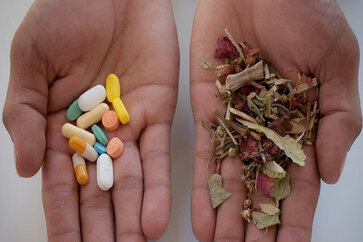Pancha Mahabhutas & Food – The Relationship With Your Dosha
In Ayurvedic texts, it is stated that the various flavors affect the action of Prana, the life force in the body and that each of the flavors has a specific influence on the three moods or dosha.
For this reason, it is necessary to understand these doshas, Vata, Pitta, and Kapha, for their specific actions and to know their constitution according to the five elements or Mahabhutas and food.
Mahabhutas & Food
According to the traditional Ayurvedic medicine of India, Ayurveda, everything that exists is made up of the 5 elements, the Panch Mahabhutas in different proportions. Each element has its own physical and subtle characteristics that determine the nature of everything of which they are part.
The Mahabhutas are at the base of everything that exists and therefore all materials and substances have characteristics or attributes of these five elements in their different processes of transformation, growth, and development.
When we talk about the five elements we mean:
- Aakash (Ether): It is the space where matter exists.
- Vayu (Air): It is the gaseous state of matter.
- Agni (Fire): It is the transforming power of matter.
- Jala (Water): It is the liquid state of matter.
- Prithvi (Earth): It is the solid-state of matter.
All these elements are not static and are in continuous transformation.
The earth is not immutable, it can be solid, hard, heavy, in contact with fire it becomes malleable, liquid, if we add liquid it turns into water, then it evaporates assuming the characteristics of air and if it continues to heat up due to the action of fire it will take the characteristics of the ether.
If it then cools it will take on the characteristics of air, water, and so on, continuing a cycle that will never be the same since there has been transformation and experience.
In food, six flavors (bitter, spicy, salty, acidic, astringent, and sweet) that are related to the mahabhutas are considered and it is essential to know this relationship to understand the action of each of them in the doshas (biotypes, moods or humor).
This knowledge and relationship between mahabhutas and diet will be decisive in choosing the right foods, the way to prepare them, and the right combinations for the well-being of a person.
Mahabutas and food
Flavor Or Rasa
- Aakash: with the air, they form a bitter taste.
- Vayu: together with fire they form the spicy flavor. Instead with ether, it would be bitter. With earth it is astringent.
- Agni or Tejas: in combination with the air they form the spicy flavor. With water, salty. With earth, the acid.
- Jala: in combination with the earth element it forms the sweet flavor. With fire, the salty.
- Prithvi: with the air element they form the astringent flavor. With water the sweet, with fire, the acid.
Temperature Or Virya
Flavors are also analyzed according to Virya, which is the capacity they have to contain energy and the property to heat or cool:
- Sweet – Cold
- Salty – Hot
- Acid – Hot
- Astringent – Cold
- Spicy – Hot
- Bitter – Cold
Lack of one or more flavors in the daily diet can lead to various imbalances and malnutrition.
Post-Digestive Effect Or Vipak
- It is also important to know the post-digestive effects (Vipak) of flavors. Sweet and salty flavors match the properties of sweet foods, while astringent, spicy, and bitter have long-term spicy Vipak.
- The post-digestive effect (Vipak) also refers to the properties of food after it is digested in the body.
- To keep your mind and body balanced, good nutrition is of utmost importance. According to Ayurveda, all foods have their own flavor (rasa), temperature (virya), and a post-digestive effect (vipak).
Mahabhutas & Food According To Your Dosha
We can see how food exacerbates or reduces energy and balance in us and this knowledge can be used to seek harmony and health according to our dosha: Vata, Pitta, or Kapha. In broad strokes let’s see this relationship and some recommendations.
1. Vata
It is recommended to give preference to sweet, acidic, and salty foods. Avoid bitter and astringent. Also, include soups and creams, boiled or heated cereals, moyashi, tofu, ginger teas, and cinnamon with brown sugar.
On the other hand, avoid dried fruits, raw vegetables, beans, and all foods considered unhealthy for the Ayurvedic diet.
2. Pitta
Bitter, sweet, and astringent flavors are recommended. Avoid acids. Include ripe and sweet fruits in the diet, vegetables such as beets and spinach, cereals, beans, unsalted butter, ghee, squash, white cheese, freshwater fish, cumin, coriander, mint, parsley, chives, bay leaf, and saffron as condiments. , coconut, almonds, and herbal teas.
Avoid garlic and onion, as well as acidic fruits and vegetables, corn, brown rice, yellow cheeses, oilseeds, and other foods not recommended by Ayurveda in general.
3. Kapha
It is suggested to avoid fatty and sweet foods. Prioritize fibers, light, and dry foods. The sweet flavors of vegetables, and also salty and acidic flavors. Include citrus, barley, quinoa, corn, tapioca, beans, peas, lentils, tofu, ginger, cayenne pepper, cinnamon, coriander, honey, and herbal teas in your diet.
Avoid very sweet fruits, raw tomatoes, tubers, rice, soybeans, olive oil, and other foods not indicated by Ayurveda in general.


























